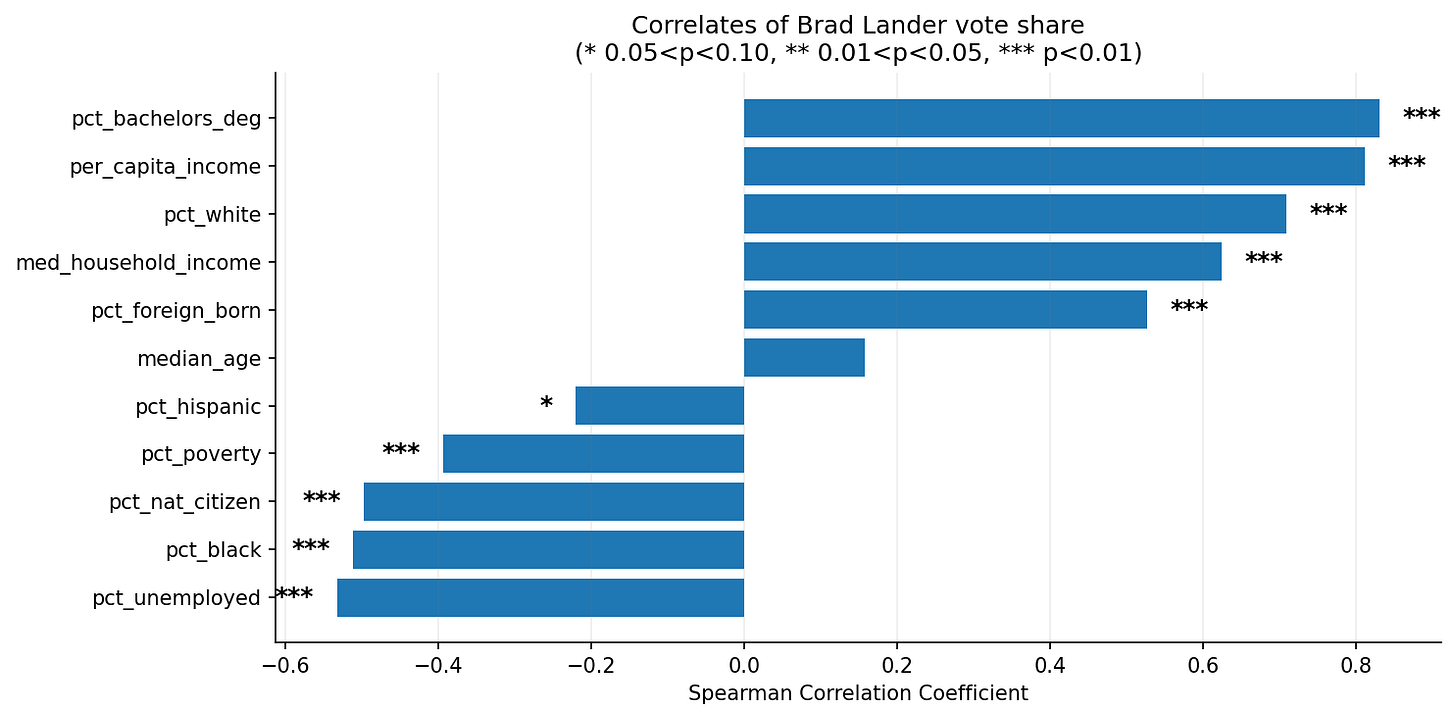The socioeconomic geospatial correlates of candidates’ vote shares contain information on their class coalitions. It is possible that there is confounding, but Occam’s razor compels us to accept the reductionist hypothesis as the null. That is, the simplest possible explanation of geospatial correlates is that groups of voters cluster both in their vote choice and their location, so the two are systematically associated. Put another way, the cause of systematic geospatial correlation is variation in the class coalitions of the candidates.
Here we document the correlates of the Mamdani vote share to understand what sorts of New Yorkers voted for him. This tells us a fair bit about his class coalition. Furthermore, Mamdani class coalition in informative about the future of the rising democratic socialist wing of the Democratic Party. So this analysis is of great interest.
We provide a ready-to-execute python script that pulls the data from the internet and replicates our analysis towards the end. We vibe-coded the whole thing with Claude-4-sonnet and Cursor AI.
The analysis is performed at the level of Assembly District. The socioeconomic and ethnodemographic data was obtained from the US Census’ American Community Survey 2023. The vote counts were obtained from the NYC Board of Elections. We report Spearman’s rank correlation coefficients because they are robust to outliers. We also show scatterplots for each feature. We report the results for two responses: Mamdani’s vote share and Lander’s vote share. The former is the main response of interest.
The following plot graphs the correlates of Mamdani’s vote share. Younger voters went heavily for Mamdani (median age: r = -0.26, P = 0.029). Unsurprisingly, so did foreign born New Yorkers (pct natural citizen: r = -0.21, P = 0.080; pct foreign born r = 0.23, P = 0.056). Mamdani persuaded Hispanic voters (r = 0.32, P = 0.007). Black voters not so much (r = -0.20, P = 0.105).
Importantly, we find that neither per capita income (r = 0.20, P = 0.105) nor median household income are significant correlates of the Mamdani vote. So, there is no significant class gradient in Mamdani’s vote share. This conclusion is corroborated by the coefficient of share of college graduates (r = 0.14, P = 0.25). This is really excellent news for the democratic socialists whose appeal in New York had been hitherto confined to the college educated and the affluent.
We find much more significant correlates for Lander’s vote share. Voters who went for Lander were overwhelmingly college-educated, affluent and white. Poor and black voters were not at all persuaded by Lander.
The scatter plots for socioeconomic correlates of the Mamdani vote show non-linear relationships. For instance, there is a positive association between income and his vote share until about $100,000, after which it becomes negative. This is likely due to confounding. Perhaps the lowest income assembly districts are dominated by Black voters who were not so persuaded by Mamdani. The negative gradient above $100,000 is politically significant—it suggests that democratic socialists were finally able to break into the working and middling classes.




The demographic correlates are also interesting. The age gradient is especially pronounced. Young voters went heavily for Mamdani. On the downside, Black voters seem to have been quite unimpressed. The pattern for Hispanics shows a small positive gradient. The gradient for natural born is non-linear, with the gradient turning from positive to negative. This is probably due to confounding by ethnic clusters.




We have shown that Mamdani won by appealing to a broad class of New Yorkers, especially younger voters. There is no pronounced class gradient in his vote share. His appeal was strongest with those with modest incomes, and weaker among lowest income (possibly confounded by race) and highest income voters. He persuaded white, Hispanics and foreign born voters. But Black New Yorkers were less persuaded.
The political upshot is that democratic socialism has broken out of the affluent progressive class to which it had hitherto been confined in the City of New York. It has made significant inroads into the working and middling classes. But so far it has failed to make inroads into the Black community.
Zohran Kwame Mamdani’s victory is proof that standing openly for democratic socialism, standing against Israeli atrocities, and focusing on bread-and-butter issues of concern to common people works. The task for democratic socialists is now twofold. First, they must make greater efforts to bring in Black Democrats. Second, they must build on this success on the national level.
The replication code can downloaded from my Dropbox by clicking here.




Expect Cuomo to run in the general as an independent, solely for the purpose of taking votes from Mamdani. That, and an all-out propaganda blitz.
Very interesting. Socialism in America. Who'd have thought?! There's still a long way to go, of course. Odd too, that it was a right-wing, Republican administration that kick-started the rehabilitation of interventionist economic policies - albeit, probably not the right ones and definitely for the wrong reasons.